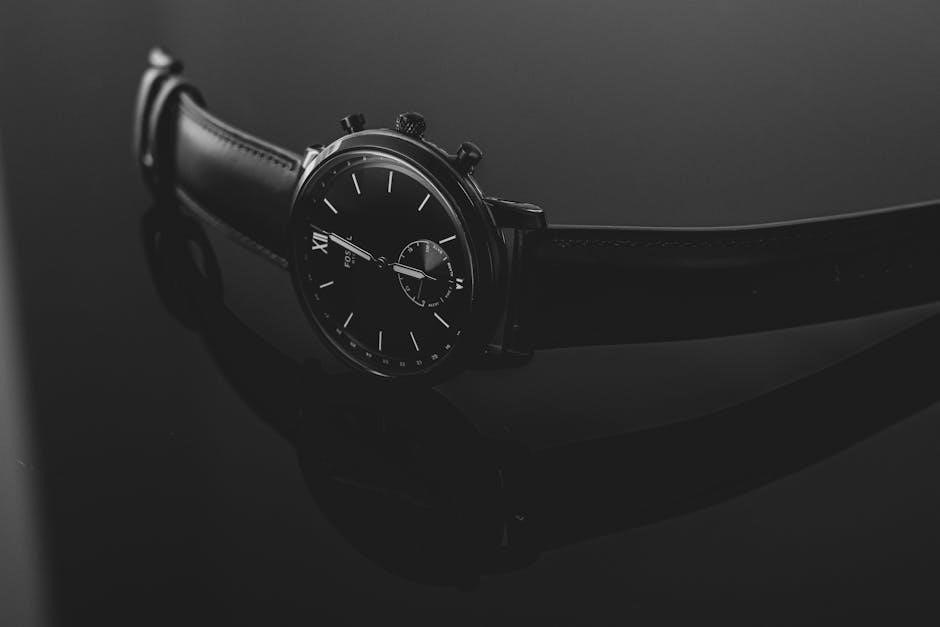Air Optix Multifocal fitting utilizes a streamlined two-step process‚ achieving a 96% success rate with two lenses or less‚ offering clear vision at all distances.
What are Air Optix Multifocal Contact Lenses?
Air Optix Multifocal contacts are designed for individuals with presbyopia‚ offering clear vision at near‚ intermediate‚ and distance. These monthly disposable lenses feature a unique Precision ProfileDesign‚ blending multiple prescription strengths seamlessly across the lens surface.
They incorporate SmartShield Technology‚ creating a protective layer against deposits‚ and TriComfort Technology for exceptional comfort. This innovative design minimizes aberrations and provides a smooth power profile‚ ensuring clear vision throughout the day‚ and are based on the same design as Cibasoft Dailies Aqua Comfort Plus Multifocal.
The Importance of a Proper Fit
A precise fit is crucial for Air Optix Multifocal lenses‚ directly impacting visual acuity and comfort. Unlike single-vision lenses‚ multifocals require careful consideration of add power‚ base curve‚ and diameter to align with individual visual needs.
An improper fit can lead to blurred vision‚ discomfort‚ or difficulty transitioning between distances. Following the recommended two-step fitting process maximizes success‚ ensuring optimal performance and patient satisfaction‚ and avoiding unnecessary refits.
Understanding the Patient
Patient history and a thorough visual needs assessment are essential before fitting Air Optix Multifocal lenses‚ ensuring optimal outcomes and satisfaction.
Patient History and Lifestyle
A comprehensive patient history is paramount. Understanding their visual demands – near work‚ computer use‚ driving distances – dictates lens selection. Inquire about prior contact lens experience‚ including successes and failures.
Lifestyle factors significantly impact the fitting process. Active individuals may require more robust lens materials. Consider occupation and hobbies; a musician needs different vision correction than a truck driver.
Detailed questioning reveals expectations and potential challenges‚ leading to a more personalized and successful Air Optix Multifocal fitting.
Refraction and Visual Needs Assessment
A thorough refraction‚ including distance and near vision‚ is crucial. Monocular and binocular acuities must be assessed. Determine the patient’s add power requirement for near tasks‚ considering reading distance and comfort.
Evaluate intermediate vision needs‚ especially for computer users. Assess binocular vision status‚ checking for phorias and fusional ranges.
Accurate refraction and understanding visual demands are foundational for a successful Air Optix Multifocal contact lens fitting‚ ensuring optimal vision correction.
The Two-Step Fitting Process
Alcon’s proven fitting method involves initial trial lens selection‚ followed by refinement and optimization via over-refraction for clear vision at all distances.
Step 1: Initial Trial Lens Selection
Begin by determining the appropriate add power based on the patient’s near vision needs and refraction. Subsequently‚ select the base curve and diameter‚ considering corneal topography and overall lens fit. This initial selection is crucial for establishing a comfortable and effective starting point. Remember‚ the goal is to provide clear vision at all distances with minimal adaptation time. Utilizing diagnostic sets streamlines this process‚ allowing for efficient exploration of various parameters to find the optimal lens for each individual patient’s unique visual requirements.
Determining Add Power
Add power selection hinges on the patient’s near addition requirement‚ typically derived from their eyeglass prescription. However‚ a monocular near addition assessment is vital for accuracy. Start with the prescribed add‚ but be prepared to adjust based on subjective responses during trial lens wear. Consider the patient’s lifestyle; more near work may necessitate a slightly stronger add. A careful balance ensures comfortable near vision without compromising distance clarity‚ optimizing the multifocal experience.
Selecting Base Curve and Diameter
Base curve and diameter choices significantly impact lens fit and comfort. Begin with the patient’s existing lens parameters‚ if known. Otherwise‚ keratometry readings guide base curve selection‚ aiming for optimal corneal coverage; Diameter selection considers palpebral fissure size and lid tension. A well-fitted lens centers properly‚ minimizing aberrations and ensuring stable vision. Trial sets are crucial for refining these parameters‚ maximizing both visual acuity and patient comfort throughout the day.
Step 2: Refinement and Optimization
Step 2 focuses on fine-tuning the fit for optimal vision and comfort. Over-refraction‚ often plus at distance‚ is common due to the lens design’s peripheral minus power. Subjective refinement‚ asking the patient about clarity at all distances‚ is key. Adjustments are made incrementally‚ prioritizing the patient’s reported experience. This iterative process ensures a personalized fit‚ maximizing visual performance and minimizing potential discomfort‚ leading to successful multifocal lens wear.
Over-Refraction Technique
The over-refraction technique is crucial for Air Optix Multifocal fitting. Due to the Precision ProfileDesign‚ which adds minus power peripherally‚ a plus refraction at distance is frequently observed. This isn’t an error‚ but a design characteristic. Over-refraction helps optimize distance acuity and minimizes aberrations. Carefully assess the patient’s response‚ adjusting power incrementally to achieve the clearest possible vision at all focal lengths‚ ensuring comfortable and effective multifocal correction.
Subjective Refinement
Subjective refinement follows over-refraction‚ focusing on the patient’s visual experience. Ask about clarity at distance‚ intermediate‚ and near‚ noting any complaints. Utilize plus and minus changes‚ individually and binocularly‚ to fine-tune vision. Encourage the patient to compare lenses‚ identifying the clearest option. Address any lingering blur or discomfort‚ optimizing the prescription for their specific visual needs and lifestyle‚ ensuring optimal comfort and visual performance.

Key Parameters for Fitting
Air Optix Multifocal offers a wide power range and diverse base curve/diameter options‚ crucial for personalized fitting and optimal visual correction for each patient.
Power Range and Availability
Air Optix Multifocal contact lenses boast an extensive power range‚ catering to a broad spectrum of refractive errors. Spherical powers are available from +3.00D to -8.00D in 0.25D steps‚ ensuring precise correction for many individuals. Add powers range from +0.75D to +3.25D in 0.25D increments‚ allowing for customized near and intermediate vision adjustments.
This wide availability simplifies the fitting process‚ increasing the likelihood of finding the ideal lens parameters for successful multifocal correction. Practitioners can efficiently address diverse visual needs with this comprehensive range.
Base Curve Options
Air Optix Multifocal lenses offer a selection of base curves to optimize corneal coverage and visual acuity. Available base curves typically include 8.6mm and 8.8mm‚ allowing for customization based on individual corneal topography. Selecting the appropriate base curve is crucial for ensuring proper lens centration and minimizing unwanted aberrations.
Careful consideration of the patient’s corneal curvature is essential during the fitting process‚ maximizing comfort and visual performance with these multifocal lenses.
Diameter Considerations
Air Optix Multifocal contact lenses are generally available in a diameter of 14.5mm. This diameter is designed to fit a broad range of patients comfortably and effectively. However‚ individual corneal size and palpebral fissure dimensions should be considered during the fitting process.
Proper diameter selection contributes to optimal lens centration‚ minimizing complications like binding or excessive movement‚ ultimately enhancing visual clarity and patient comfort.
Diagnostic Fitting Techniques
Evaluate trial lenses using slit lamp biomicroscopy‚ assessing lens movement and centration for optimal fit and vision correction with Air Optix Multifocal.
Trial Lens Evaluation
Trial lens evaluation is crucial for Air Optix Multifocal fitting success. Observe lens movement‚ especially during primary gaze and blink; excessive movement indicates a poor fit. Assess centration – the lens should remain centered on the cornea.
Evaluate the tear film quality and quantity under the lens; Confirm clear vision at all distances‚ noting any complaints of blurriness or distortion. A proper evaluation guides refinement for optimal comfort and visual acuity.
Slit Lamp Biomicroscopy
Slit lamp biomicroscopy is essential during Air Optix Multifocal fitting. Examine the lens for proper fit‚ assessing corneal coverage‚ limbal clearance‚ and overall lens position. Inspect for any signs of compression‚ folds‚ or impingement on the conjunctiva.
Evaluate the tear film beneath the lens for stability and quality; Look for any epithelial microcysts or other corneal irregularities. Careful biomicroscopy ensures lens health and patient comfort.
Assessment of Lens Movement and Centration
Proper Air Optix Multifocal lens movement and centration are crucial for optimal vision. Observe lens movement with blink and gaze in all directions; excessive movement indicates a poor fit. Centration should be concentric‚ ensuring the multifocal zones align with the visual axis.
Decentration can cause visual disturbances. Assess for adequate clearance to avoid corneal compression and ensure sufficient oxygen transmission. Evaluate these parameters under high magnification for accurate assessment.
Addressing Common Fitting Challenges
Air Optix Multifocal challenges often involve distance‚ near‚ or intermediate vision. Over-refraction and adjustments to add power can resolve these issues effectively.
Managing Distance Vision Complaints
Distance vision complaints with Air Optix Multifocal lenses frequently stem from insufficient minus power in the periphery‚ a characteristic of the Precision ProfileDesign. This often necessitates a plus power over-refraction during the fitting process. Carefully assess the refraction and consider a slight increase in add power if needed. Ensure proper lens centration and consider a diagnostic set change to optimize distance acuity. Thorough patient communication regarding adaptation is also crucial for successful outcomes.
Correcting Near Vision Issues
Near vision issues with Air Optix Multifocal lenses often indicate insufficient add power. Begin by increasing the add power in 0.25D increments during subjective refinement. Evaluate the patient’s performance at intermediate distances as well‚ as adjustments can impact both near and intermediate vision. Confirm proper reading addition and consider a binocular balance to ensure comfortable and clear near vision. Patient feedback is key to achieving optimal near visual acuity.
Handling Intermediate Vision Problems
Intermediate vision challenges with Air Optix Multifocal lenses frequently require careful adjustment of add power and lens design. Often‚ a slight reduction in add power or a modification to the lens’s power profile can improve intermediate clarity. Assess the patient’s typical intermediate distances – computer screens‚ for example – and tailor the prescription accordingly. Consider over-refraction to fine-tune intermediate vision‚ ensuring comfortable and functional sight.

SmartShield and TriComfort Technology
SmartShield Technology creates a protective barrier against deposits‚ while TriComfort Technology ensures lasting moisture and breathability for all-day comfort.
Benefits of SmartShield Technology
SmartShield Technology is a crucial component of Air Optix Multifocal lenses‚ creating an ultra-thin protective layer that shields the lens surface. This innovative feature minimizes deposit buildup‚ significantly improving lens wettability and overall comfort throughout the day. By preventing irritating deposits from adhering to the lens‚ SmartShield helps maintain clear and consistent vision. This technology contributes to reduced protein and lipid accumulation‚ promoting healthier lens wear and extending the lifespan of the contact lenses‚ ultimately enhancing the patient experience.
Understanding TriComfort Technology
TriComfort Technology‚ integrated into Air Optix Multifocal lenses‚ focuses on maximizing breathability‚ moisture retention‚ and oxygen permeability. This three-pronged approach ensures exceptional comfort‚ even during extended wear. The silicone hydrogel material allows a high flow of oxygen to the cornea‚ promoting healthy eyes; Combined with the moisture-infused lens surface‚ TriComfort minimizes dryness and irritation‚ delivering a consistently comfortable wearing experience for multifocal contact lens patients throughout their active days.

Prescription Considerations
Eyeglass prescriptions differ from contact lens prescriptions; a comprehensive eye exam by a professional is crucial for proper fit and accurate specifications.
Eyeglass vs. Contact Lens Prescriptions
It’s essential to understand that your standard eyeglass prescription isn’t directly transferable to contact lenses like Air Optix Multifocal. Eyeglass prescriptions measure how light bends when passing through spectacle lenses‚ positioned at a distance from your eye. Contact lenses‚ however‚ sit directly on the cornea‚ requiring additional parameters.
These include base curve and diameter‚ crucial for comfort and vision. A proper contact lens fitting‚ performed by an optometrist or ophthalmologist‚ determines these specifications alongside your prescription power‚ ensuring optimal vision and lens fit. Don’t attempt to self-prescribe!
Importance of a Current Contact Lens Prescription
Maintaining an up-to-date contact lens prescription is paramount for successful Air Optix Multifocal fitting. Your vision and corneal shape can change over time‚ impacting lens fit and visual acuity. An expired prescription risks discomfort‚ blurred vision‚ and potentially corneal health issues.
Regular eye exams‚ ideally annually‚ ensure your prescription accurately reflects your current needs. This is especially crucial when switching to multifocal lenses‚ as precise measurements are vital for seamless distance‚ intermediate‚ and near vision correction.

Precision ProfileDesign Explained
Precision ProfileDesign adds minus power peripherally‚ minimizing aberrations and creating a smooth power profile for clear vision at all distances‚ often requiring plus over-refraction.
Minus Power in the Periphery
Air Optix Multifocal lenses incorporate a unique design feature: the addition of minus power in the lens periphery. This strategic placement isn’t a flaw‚ but a deliberate choice to optimize visual performance. By increasing minus power towards the edges‚ the lens effectively minimizes spherical aberrations‚ common visual distortions that can blur vision.
This design contributes to a smoother‚ more seamless transition between distance‚ intermediate‚ and near vision zones‚ enhancing overall clarity and comfort for presbyopic patients. The periphery’s minus power aids in reducing halo and glare effects‚ particularly noticeable in low-light conditions.
Minimizing Aberrations
Air Optix Multifocal lenses are engineered to significantly reduce visual aberrations‚ improving clarity and visual quality for presbyopic patients; The Precision ProfileDesign‚ with its strategic addition of minus power in the periphery‚ plays a crucial role in this process. This design minimizes spherical aberrations‚ which often cause blurry or distorted vision‚ especially at distance.
Consequently‚ patients often experience a plus power over-refraction at distance‚ a predictable outcome of this design. By controlling aberrations‚ these lenses deliver sharper‚ more natural vision across all focal ranges.

Fitting Success Rates
Alcon’s Air Optix Multifocal boasts impressive fitting success‚ with a 96% rate achieved using two lenses or fewer during the initial fitting process.
Alcon Multifocal Fitting Success
Alcon consistently demonstrates high success rates with its multifocal contact lens fitting process. The unique design philosophy‚ coupled with a straightforward two-step initial fitting‚ contributes to a remarkable 96% success rate when utilizing two lenses or fewer. This efficiency benefits both practitioners and patients‚ minimizing chair time and maximizing patient satisfaction.
The streamlined approach ensures a greater likelihood of achieving optimal vision correction and comfort from the outset‚ solidifying Air Optix Multifocal as a reliable choice.
Factors Influencing Fitting Success
Several key elements impact the success of Air Optix Multifocal fittings. Accurate patient history‚ a thorough refraction‚ and precise assessment of visual needs are crucial starting points. Adhering to the two-step fitting process – initial trial and refinement – significantly boosts outcomes.
Proper over-refraction and subjective refinement techniques‚ alongside careful consideration of lens parameters‚ also play vital roles in achieving optimal vision and patient comfort; Individual corneal characteristics also contribute.

Troubleshooting Fitting Issues
Air Optix Multifocal challenges like discomfort‚ blurred vision‚ or dry eyes often require adjustments to lens parameters or refinement of the prescription.
Lens Discomfort
Lens discomfort with Air Optix Multifocal lenses can stem from several factors. Evaluate lens fit – tightness can cause irritation‚ while excessive movement leads to awareness. Assess lens surface deposits; SmartShield Technology helps‚ but cleaning is vital.
Consider patient tear film quality; dry eye exacerbates discomfort. A trial with a different base curve or diameter might resolve fit issues. Finally‚ confirm the prescription is accurate‚ as incorrect power can strain eyes and induce discomfort.
Blurred Vision
Blurred vision with Air Optix Multifocal lenses often requires a thorough refraction check and over-refraction. Incorrect add power is a common culprit; refine it subjectively. Verify proper centration – decentration impacts visual clarity.
Assess tear film stability‚ as fluctuations blur vision. Confirm the lens isn’t damaged. If issues persist‚ consider a trial with a different base curve or diameter to optimize the optical zone alignment with the patient’s pupil.
Dry Eye Symptoms
Dry eye significantly impacts Air Optix Multifocal lens comfort and vision. Multifocal designs can exacerbate dryness due to reduced tear exchange under the lens. Recommend artificial tears and assess tear film quality before fitting.
Ensure proper lens care to remove deposits that attract dryness. Consider a daily disposable option if symptoms are severe. Evaluate blinking patterns; incomplete blinks worsen dryness. Address underlying causes like meibomian gland dysfunction.

Follow-Up and Patient Education
Follow-up visits are crucial for Air Optix Multifocal success‚ ensuring comfort and clear vision. Proper lens care instructions maximize lens health and longevity.
Importance of Follow-Up Visits
Follow-up visits are paramount after an Air Optix Multifocal fitting. Initial success doesn’t guarantee long-term satisfaction; adjustments may be needed. These visits assess lens performance‚ address any discomfort‚ and refine the prescription for optimal vision at all distances. Evaluating lens movement‚ centration‚ and overall ocular health ensures continued success.
Furthermore‚ follow-ups allow for patient feedback‚ crucial for identifying subtle issues not apparent during the initial fitting. Consistent monitoring maximizes comfort‚ visual acuity‚ and patient compliance with lens wear and care.
Proper Lens Care Instructions
Air Optix Multifocal lenses require diligent care for optimal performance and eye health. Patients must be instructed on proper handling‚ cleaning‚ and storage techniques. Daily cleaning with a multipurpose solution removes deposits‚ preventing discomfort and infection.
Rubbing the lenses gently‚ rinsing thoroughly‚ and storing them in fresh solution overnight is essential. Avoid tap water‚ as it contains harmful microorganisms. Regular case replacement and adherence to the prescribed wearing schedule are also crucial for maintaining lens integrity and visual clarity.

Resources for Practitioners
Alcon provides comprehensive fitting guides and online support‚ including training modules‚ to assist practitioners in successful Air Optix Multifocal fittings.
Alcon Fitting Guides
Alcon offers detailed fitting guides specifically designed for Air Optix Multifocal contact lenses. These resources streamline the fitting process‚ emphasizing the crucial two-step initial fitting process. They provide clear instructions on initial trial lens selection‚ including determining add power and selecting appropriate base curves and diameters.
Furthermore‚ the guides detail refinement and optimization techniques like over-refraction and subjective refinement. Practitioners can access these guides to enhance efficiency and improve first-time fit success rates‚ ultimately benefiting patients seeking multifocal correction.
Online Support and Training
Alcon provides extensive online support and training resources to assist practitioners in mastering Air Optix Multifocal fitting. These platforms offer access to webinars‚ case studies‚ and interactive modules focused on the two-step fitting process.
Practitioners can deepen their understanding of key parameters‚ diagnostic techniques‚ and troubleshooting strategies. This digital support ensures clinicians are well-equipped to achieve optimal fitting success and deliver exceptional patient care with these advanced multifocal lenses.

Latest Updates and Innovations
Air Optix Multifocal design continues to evolve‚ with ongoing developments focused on enhancing the power profile and minimizing aberrations for improved vision.
New Developments in Air Optix Multifocal Design
Recent innovations in Air Optix Multifocal lenses center around refining the Precision ProfileDesign. This design strategically incorporates minus power in the lens periphery‚ aiming to minimize aberrations and deliver consistently clear vision. This approach often necessitates a slight plus power over-refraction during distance assessments. Alcon’s commitment to improvement focuses on optimizing the blend of prescription strengths across the lens surface‚ ensuring seamless transitions between distances. These advancements build upon the established two-step fitting process‚ further enhancing success rates and patient satisfaction with multifocal contact lens wear.
Future Trends in Multifocal Contact Lenses
The future of multifocal contact lenses‚ including Air Optix‚ likely involves increasingly personalized designs. Expect advancements in utilizing artificial intelligence to predict optimal parameters based on individual corneal topography and visual needs. Enhanced materials offering greater oxygen permeability and deposit resistance are also anticipated. Furthermore‚ dynamic multifocal designs that adjust to varying viewing distances in real-time could emerge‚ improving visual acuity and comfort. These trends aim to simplify the fitting process and maximize patient success with multifocal correction.













































